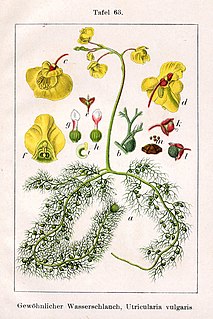
Utricularia, commonly and collectively called the bladderworts, is a genus of carnivorous plants consisting of approximately 233 species. They occur in fresh water and wet soil as terrestrial or aquatic species across every continent except Antarctica. Utricularia are cultivated for their flowers, which are often compared with those of snapdragons and orchids, especially amongst carnivorous plant enthusiasts.

Utricularia gibba, commonly known as the humped or floating bladderwort, is a small, mat-forming species of carnivorous aquatic bladderwort. It is found on all continents except Antarctica.
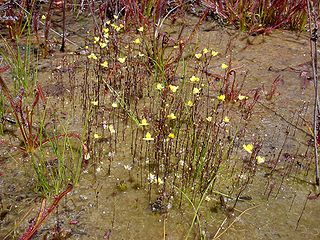
Utricularia subulata, the zigzag bladderwort, is a small annual, terrestrial carnivorous plant that belongs to the genus Utricularia. It is the most widely distributed species in the genus, being almost pantropical.

Utricularia foliosa, the leafy bladderwort, is a large suspended aquatic carnivorous plant that belongs to the genus Utricularia. It is probably a perennial plant. U. foliosa is native to Africa and North and South America, widely distributed among many countries.

Utricularia stellaris is a medium to large sized suspended aquatic carnivorous plant that belongs to the genus Utricularia. U. stellaris is native to Africa, tropical Asia, and northern Australia.
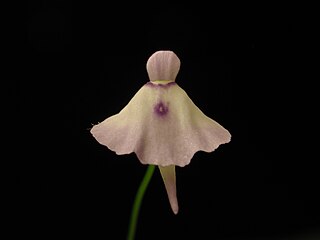
Utricularia pubescens is a small to medium-sized, probably annual, terrestrial or lithophytic carnivorous plant that belongs to the genus Utricularia and is the only member of Utricularia sect. Lloydia. U. pubescens is native to India, tropical Africa, and Central and South America. It was originally published and described by James Edward Smith in 1819 and placed in its own section, Lloydia, by Peter Taylor in 1986. It grows as a terrestrial or lithophytic plant in boggy grasslands in damp peaty soils at altitudes from sea level to 1,900 m (6,234 ft). This species possesses small peltate leaves, which are diagnostic for this species in the genus.
Utricularia rigida is a small to medium-sized perennial, rheophytic carnivorous plant that belongs to the genus Utricularia. U. rigida is endemic to western tropical Africa, where it can be found in Côte d'Ivoire, Guinea, Guinea-Bissau, Mali, Nigeria, Senegal, and Sierra Leone. It grows as a rheophyte on inclined rock faces in swiftly running water at altitudes from near sea level to 1,250 m (4,101 ft). It was originally described and published by Ludwig Benjamin in 1847. It is distinguished from the other species in the section, U. tetraloba, by having only two lower lip corolla lobes as opposed to U. tetraloba's four.
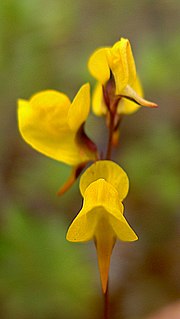
Utricularia juncea, the southern bladderwort, is a small to medium sized, probably perennial carnivorous plant that belongs to the genus Utricularia. U. juncea is native to Central, South, and North America. It grows as a terrestrial plant in marshes, swamps, and pools in shallow waters, mostly at lower altitudes. It was originally described and published by Martin Vahl in 1804.

Utricularia sect. Nigrescentes is a section in the genus Utricularia. The three species in this section are small terrestrial carnivorous plants native to tropical Africa, Asia, and Australia. Daniel Oliver originally validly described and published this section in 1859, but did not specify the rank used by the group. Sadashi Komiya revised the section in 1973. Peter Taylor, in his 1989 taxonomic monograph on the genus, placed this section within subgenus Utricularia. More recent phylogenetic data and revisions have reinstated subgenus Bivalvaria and have placed this section within it.
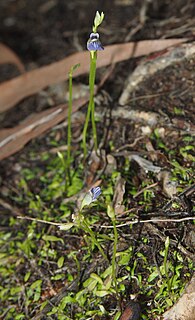
Utricularia caerulea, the blue bladderwort, is a very small to medium-sized carnivorous plant that belongs to the genus Utricularia. U. caerulea spans a wide native range, including areas in tropical Africa, Asia, and Australia. It grows as a terrestrial plant in wet, shallow soils over rock, in wet grasslands, in swamps, or near streams in open communities, mostly at lower altitudes but ascending to as much as 2,100 m (6,890 ft). It was originally described and published by Carl Linnaeus in 1753.
Utricularia simulans, the fringed bladderwort, is a small to medium-sized, probably perennial, carnivorous plant that belongs to the genus Utricularia. U. simulans is native to tropical Africa and the Americas. It grows as a terrestrial plant in damp, sandy soils in open savanna at altitudes from near sea level to 1,575 m (5,167 ft). U. simulans was originally described and published by Robert Knud Friedrich Pilger in 1914.

Utricularia arenaria is a small annual carnivorous plant that belongs to the genus Utricularia. It is native to tropical and southern Africa, where it can be found in Angola, Burundi, Cameroon, Côte d'Ivoire, the Democratic Republic of the Congo, Ethiopia, Gabon, Ghana, Kenya, Madagascar, Malawi, Mali, Mozambique, Nigeria, Senegal, Sierra Leone, South Africa, Sudan, Tanzania, Togo, Uganda, Zambia, and Zimbabwe. There has also been a single collection from central India in Madhya Pradesh. U. arenaria grows as a terrestrial plant in damp, sandy or peaty soils in swampy grasslands or marshes at altitudes from near sea level to 2,400 m (7,874 ft). It was originally described and published by Alphonse Pyrame de Candolle in 1844.
Utricularia welwitschii is a small to medium-sized, probably perennial, carnivorous plant that belongs to the genus Utricularia. It is endemic to tropical Africa, where it can be found in the Democratic Republic of the Congo, Madagascar, Malawi, South Africa, Tanzania, Zambia, and Zimbabwe. U. welwitschii grows as a terrestrial plant in sandy or peaty soils in marshy grasslands at altitudes from 1,000 m (3,281 ft) to 2,200 m (7,218 ft). It was originally described and published by Daniel Oliver in 1865. Taylor previously described two varieties of U. welwitschii, U. welwitschii var. odontosepala and U. welwitschii var. microcalyx, in 1964, but later elevated them to the rank of species as U. odontosepala and U. microcalyx, respectively. It is named in honor of Friedrich Welwitsch.

Utricularia sect. Oligocista is the largest section in the genus Utricularia. The 42 species in this section are small to medium-sized terrestrial carnivorous plants native throughout the tropics, with six species in the Americas, ten in Africa, five in Australia, and the remainder in Asia, with 17 mostly native to peninsular India. Alphonse Pyrame de Candolle originally described and published this section in 1844. Peter Taylor published his taxonomic monograph of Utricularia in 1986, in which he placed this section within subgenus Utricularia. More recent phylogenetic data and revisions have reinstated subgenus Bivalvaria and have placed this section within it.
Utricularia foveolata is a small, probably annual, carnivorous plant that belongs to the genus Utricularia. It is native to the Old World tropics, where it can be found in Africa, Asia, Australia, and on the eastern end of Java. U. foveolata grows as a terrestrial or subaquatic plant in wet soils or in shallow water, sometimes as a weed in rice fields in Asia. It was originally described and published by Michael Pakenham Edgeworth in 1847.
Utricularia odorata is a medium-sized, probably perennial carnivorous plant that belongs to the genus Utricularia. It is native to southeastern Asia and northern Australia. U. odorata grows as a terrestrial plant in wet grasslands at low altitudes. It was originally described by François Pellegrin in 1920. The specific epithet odorata is derived from reports that the flowers are fragrant.

Utricularia scandens is a small, probably annual carnivorous plant that belongs to the genus Utricularia. It has a wide native distribution that includes Africa and Asia. U. scandens grows as a terrestrial plant in wet grasslands and bogs at lower altitudes around sea level up to 2,300 m (7,546 ft). It was originally described by Ludwig Benjamin in 1847. There is a significant amount of synonymy established for this species, in part because of its large distribution and variable morphology.
Utricularia spiralis is a medium to large-sized, probably perennial carnivorous plant that belongs to the genus Utricularia. It is endemic to tropical Africa and can be found in Angola, Burundi, Chad, Côte d'Ivoire, the Democratic Republic of the Congo, Gabon, Guinea, Liberia, Malawi, Sierra Leone, Tanzania, and Zambia. U. spiralis grows as a terrestrial plant in swamps or marshes in peaty or sandy soils at altitudes from sea level to 1,860 m (6,102 ft). It was originally described by James Edward Smith in 1819.

Utricularia uliginosa, the Asian bladderwort, is a small annual carnivorous plant that belongs to the genus Utricularia. It is native to Southeast Asia, Oceania, and Australia. U. uliginosa grows as a terrestrial or subaquatic plant in seasonally flooded shallow pools with sandy soils or on banks and among rocky stream beds at low altitudes. It was originally described by Martin Vahl in 1804.














